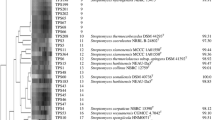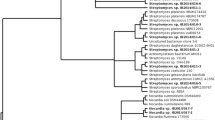Abstract
Stenotrophomonas maltophilia is known to be of significance as opportunistic pathogen as well as a source of biocontrol and bioremediation activities. S. maltophilia strains have been isolated from rhizospheres, soil, clinical material, aquatic habitats, but little is known about Stenotrophomonas strains recovered from marine environments. During a survey of the biodiversity of Pseudomonas-like bacteria associated with deep-sea invertebrates six Stenotrophomonas strains were isolated from sponge, sea urchin, and ophiura specimens collected from differing Pacific areas, including the Philippine Sea, the Fiji Sea and the Bering Sea. 16S rRNA gene sequence analysis confirmed an assignment of marine isolates to the genus Stenotrophomonas as it placed four strains into the S. maltophilia CIP 60.77T cluster and two related to the S. rhizophila DSM 14405T. Together with a number of common characteristics typical of S. maltophilia and S. rhizophila marine isolates exhibited differences in pigmentation, a NaCl tolerance, a range of temperatures, which supported their growth, substrate utilization pattern, and antibiotics resistance. Strains displayed hemolytic and remarkable inhibitory activity against a number of fungal cultures and Gram-positive microorganisms, but very weak or none against Candida albicans. This is the first report on isolation, taxonomic characterization and antimicrobial activity of Stenotrophomonas strains isolated from deep-sea invertebrates.


Similar content being viewed by others
References
Berg G, Marten P, Ballin G (1996) Stenotrophomonas maltophilia in the rhizosphere of oilseed rape—occurrence, characterization and interaction with phytopathogenic fungi. Microbiol Res 151:19–27
Berg G, Roskot N, Smalla K (1999) Genotypic and phenotypic relationships between clinical and environmental isolates of Stenotrophomonas maltophilia. J Clin Microbiol 37:3594–3600
Coenye T, Vanlaere E, Falsen E, Vandamme P (2004) Stenotrophomonas africana Drancourt et al. 1997 is a later synonym of Stenotrophomonas maltophilia (Hugh 1981) Palleroni and Bradbury 1993. Int J Syst Evol Microbiol 54:1235–1237
Denton M, Kerr KG (1998) Microbiological and clinical aspects of infections associated with Stenotrophomonas maltophilia. Clin Microbiol Rev 11:7–80
Drancourt MC, Bollet C, Raoult D (1997) Stenotrophomonas africana sp. nov., an opportunistic human pathogen in Africa. Int J Syst Bacteriol 47:160–163
Felsenstein J (1989) PHYLIP—phylogeny inference package (version 3.2). Cladistics 5:164–166
Furushita M, Okamoto A, Maeda T, Ohta M, Shiba T (2005) Isolation of multidrug-resistant Stenotrophomonas maltophilia from cultured yellowtail (Seriola quinqueradiata) from a marine fish farm. Appl Environ Microbiol 71:5598–5600
Gerner-Smidt P, Bruun B, Arpi M, Schmidt J (1995) Diversity of nosocomial Xanthomonas maltophilia (Stenotrophomonas maltophilia) as determined by ribotyping. Eur J Clin Microbiol Infect Dis 14:137–140
Hauben L, Vauterin L, Moore ERB, Hoste M, Swings J (1999) Genomic diversity of the genus Stenotrophomonas. Int J Syst Bacteriol 49:1749–1760
Hoffmann A, Thimm T, Droege M, Moore ERB, Munch JC, Tebbe CC (1998) Intergeneric transfer of conjugative and mobilizable plasmids harbored by Escherichia coli in the gut of the soil microarthropod Folsomia candida (Collembola). Appl Environ Microbiol 64:2652–2659
Hugh R (1981) Pseudomonas maltophilia sp. nov. nom. rev. Int J Syst Bacteriol 31:195
Jacobi M, Kaiser D, Berg G, Jung G, Winkelmann G, Banl H (1996) Maltophilin—a new antifungal compound produced by Stenotrophomonas maltophilia R3089. J Antibiot 49:1101–1104
Kimura M (1980) A simple method for estimating evolutionary rates of base substitutions through comparative studies of nucleotide sequences. J Mol Evol 16:111–120
Laramee L, Lawrence JR, Greer CW (2000) Molecular analysis and development of 16S rRNA oligonucleotide probes to characterize a diclofop-methyl-degrading biofilm consortium. Can J Microbiol 46:133–142
Lindh JM, Terenius O, Faye I (2005) 16S rRNA gene-based identification of midgut bacteria from field-caught Anopheles gambiae sensu lato and A. funestus mosquitoes reveals new species related to known insect symbionts. Appl Environ Microbiol 71:7217–7223
Minkwitz A, Berg G (2001) Comparison of antifungal activities and 16S ribosomal DNA sequences of clinical and environmental isolates of Stenotrophomonas maltophilia. J Clin Microbiol 39:139–145
Palleroni NJ, Bradbury JF (1993) Stenotrophomonas, a new bacterial genus for Xanthomonas maltophilia, (Hugh 1980) Swings et al. 1983. Int J Syst Bacteriol 43:606–609
Ribbeck-Busch K, Roder A, Hasse D, De Boer W, Martinez JL, Hagemann M, Berg G (2005) A molecular biological protocol to distinguish potentially human pathogenic Stenotrophomonas maltophilia from plant-associated Stenotrophomonas rhizophila. Environ Microbiol 7:1853–1858
Romanenko LA, Lysenko AM, Rohde M, Mikhailov VV, Stackebrandt E (2004) Psychrobacter maritimus sp. nov., and Psychrobacter arenosus sp. nov., isolated from coastal sea-ice and sediments of the Sea of Japan. Int J Syst Evol Microbiol 54:1741–1745
Romanenko LA, Uchino M, Falsen E, Frolova GM, Zhukova NV, Mikhailov VV (2005) Pseudomonas pachastrellae sp. nov., isolated from a marine sponge. Int J Syst Evol Microbiol 55:919–924
Romanenko LA, Uchino M, Frolova GM, Tanaka N, Kalinovskaya NI, Latyshev N, Mikhailov VV (2007) Sphingomonas molluscorum sp. nov., a novel marine isolate with antimicrobial activity. Int J Syst Evol Microbiol 57:358–363
Saitou N, Nei M (1987) The neighbor-joining method: a new method for reconstructing phylogenetic trees. Mol Biol Evol 4:406–425
Seibold A, Wichels A, Schütt C (2001) Diversity of endocytic bacteria in the dinoflagellate Noctiluca scintillans. Aquat Microb Ecol 25:229–235
Shida O, Takagi H, Kadowaki K, Nakamura LK, Komagata K (1997) Transfer of Bacillus alginolyticus, Bacillus chondroitinus, Bacillus curdlanolyticus, Bacillus glucanolyticus, Bacillus kobensis, and Bacillus thiaminolyticus to the genus Paenibacillus and emended description of the genus Paenibacillus. Int J Syst Bacteriol 47:289–298
Smibert RM, Krieg NR (1994) Phenotypic characterization. In: Gerhardt P, Murray RGE, Wood WA, Krieg NR (eds) Methods for general and molecular bacteriology. American Society for Microbiology, Washington, DC, pp 607–655
Swings J, De Vos P, Van Den Mooter M, De Ley J (1983) Transfer of Pseudomonas maltophilia Hugh 1981 to the genus Xanthomonas as Xanthomonas maltophilia (Hugh 1981) comb. nov. Int J Syst Bacteriol 33:409–413
Thompson JD, Gibson TJ, Plewniak F, Jeanmougin F, Higgins DG (1997) The ClustalX windows interface: flexible strategies for multiple sequence alignment aided by quality analysis tools. Nucleic Acids Res 24:4876–4882
Van Den Mooter M, Swings J (1990) Numerical analysis of 295 phenotypic features of 266 Xanthomonas strains and related strains and an improved taxonomy of the genus. Int J Syst Bacteriol 40:348–369
Wolf A, Fritze A, Hagemann M, Berg G (2002) Stenotrophomonas rhizophila sp. nov., a novel plant-associated bacterium with antifungal properties. Int J Syst Evol Microbiol 52:1937–1944
Acknowledgments
We would like to thank Dr. Chantal Bizet, the Collection de l’Institut Pasteur, Institut Pasteur, CIP, Paris, France, for providing the type strain of Stenotrophomonas maltophilia CIP 60.77T and indicator strains. This study was supported by a grant from the Russian Foundation for Basic Research (RFBR) and the Far-Eastern Branch of Russian Academy of Sciences (RAS) 06-04-96007, grant from the Far-Eastern Branch of RAS 06-III-A-06183, and by grant from Presidium of RAS “Molecular and Cell Biology” and grant from President of the Russian Federation “Leading Scientific School of RF (6477.2006.4)”.
Author information
Authors and Affiliations
Corresponding author
Additional information
Communicated by Erko Stackebrandt.
Rights and permissions
About this article
Cite this article
Romanenko, L.A., Uchino, M., Tanaka, N. et al. Occurrence and antagonistic potential of Stenotrophomonas strains isolated from deep-sea invertebrates. Arch Microbiol 189, 337–344 (2008). https://doi.org/10.1007/s00203-007-0324-8
Received:
Revised:
Accepted:
Published:
Issue Date:
DOI: https://doi.org/10.1007/s00203-007-0324-8




